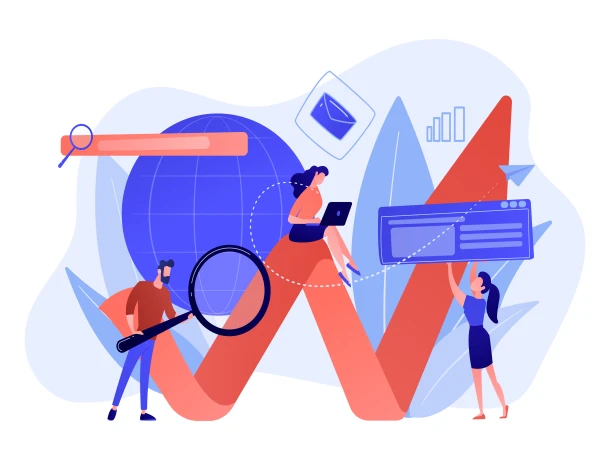
- August 5, 2025
- Digital Marketing, seo
- Digital Marketing
Table of Contents
What is Link Velocity?
Link velocity is the rate at which a website obtains backlinks over a set length of time. Simply said, it monitors how fast (or slowly) other websites link to your site.
This idea is significant in SEO because search engines such as Google utilize link velocity to assess the natural growth of a website’s backlink profile. A consistent and organic increase in links typically indicates that your material is valuable and attracting attention. On the other hand, a rapid increase in backlinks, particularly from low-quality or irrelevant sites, can indicate unnatural link-building tactics.
A viral blog post can generate 100 backlinks within a week, indicating significant link velocity. A new website receiving 1,000 backlinks overnight from bogus directories? That’s questionable link velocity, which may result in a penalty.
Why Link Velocity Matters in SEO
Link velocity influences how search engines perceive and rank your website. It’s not just how many backlinks you receive, but how quickly you obtain them. Here’s why this matters:
- Indicator of Content Popularity: A continuous growth in backlinks indicates that your material is getting momentum organically. Google may perceive this as evidence that your material is relevant, authoritative, and deserving of higher rankings.
- Detects unnatural SEO tactics: Sudden increases in backlinks, particularly from unrelated or low-quality sites, can raise suspicion. Google’s algorithms are meant to spot patterns that could be caused by black hat practices such as link purchase or artificial link building.
- Boosts trust and authority signals: Gradual, consistent link growth increases your domain’s authority over time. An inconsistent or contrived link velocity can have the opposite effect, making your website appear manipulative or spammy.
- Google algorithms monitor it: Google’s Penguin and other link-related algorithms use link velocity to detect deceptive SEO techniques. If your site receives an excessive number of links for no apparent cause (such as a viral post), it may face a human evaluation or rating suppression.
- Affects new and established sites Differently: New websites with unusually fast link growth may cause suspicion.Established sites are expected to have higher link velocity due to their existing readership and authority.
Search engines reward regular, natural link growth. Managing your link velocity responsibly contributes to long-term SEO success and keeps your backlink profile clean and credible.
Factors That Influence Link Velocity
Link velocity does not occur in a vacuum; it is determined by a combination of internal and external factors. Here are the main factors that can affect how quickly (or slowly) a website gains backlinks:
- Content Virality: Viral blog pieces, films, or infographics can naturally attract a surge in backlinks within a short period. Examples include popular news items, contentious viewpoints, and highly shareable content types.
- Public relations and media coverage: PR campaigns, news releases, and media mentions can boost your link velocity overnight. Being published in authoritative journals like Forbes or TechCrunch generates credible backlinks quickly.
- Product Launches/Events: Announcements of new products, services, or important events frequently result in an increase in web mentions and backlinks. This effect is commonly observed by technology companies, startups, and brands running major campaigns.
- SEO and link building strategies: Guest posting, blogger outreach, and HARO submissions are all examples of intentional initiatives that might help you establish links over time. However, extremely aggressive or automated link-building might result in unnatural link velocity.
- Social media sharing: Highly shared content on Twitter, LinkedIn, and Reddit can generate both direct and referral backlinks.The more a piece of content circulates, the better its chances of gaining organic links.
- Paid or Link Schemes: Purchasing backlinks or joining private blog networks (PBNs) can result in sudden link spikes.This fake growth is hazardous and frequently results in search engine penalties.
- Content updates or re-optimization: Updating and re-promoting older material can revive interest and generate a new wave of backlinks.Ahrefs and BuzzSumo are useful tools for identifying older content that may recover traction.
- Competitor Activity: Your link velocity may change in response to your competitors’ actions, particularly if you are in a dynamic niche. Keeping up with rival backlink trends can help you develop your own approach.
Healthy link velocity is typically the result of sustained, organic efforts, whereas abrupt or manipulated growth may raise red concerns. Knowing these elements allows you to develop long-term link acquisition tactics.
Positive vs. Negative Link Velocity

Understanding the distinction between positive and negative link velocity is critical for developing a strong backlink profile and avoiding SEO penalties. Here’s the breakdown:
Positive link velocity
- An indicator of organic, trustworthy growth in your backlink profile.
- Characteristics include gradual and consistent backlink growth over time.
- Links originate from reputable websites.
- Mostly gained organically through high-quality content or public relations.
- Consistent with the site’s size, focus, and age.
- Increases domain authority steadily without raising red flags.
Examples include a blog post that receives 5-10 new links weekly after being shared on social media. A product review that gradually builds backlinks as more people discover and recommend it. Ongoing guest posting for industry-relevant websites.
Negative link velocity
- A warning flag of artificial or deceptive link-building tactics.
- Characteristics include sudden spikes in backlinks, particularly to new domains.
- Links to low-quality, spammy, or unrelated sites.
- Use automatic link-building tools or buy backlinks.
- Unnatural anchor text patterns, or the use of identical anchors.
- May result in algorithmic penalties (e.g., Google Penguin).
For instance, a new website may receive 1,000 backlinks from unrelated directories within a week. An eCommerce product page experiences an overnight backlink increase after acquiring bulk links.
A backlink profile reveals a large number of links that include exact-match keywords and connect to a money page. Google doesn’t just count links; it also tracks how quickly you receive them. Maintaining a natural and consistent link velocity is critical to establishing authority without incurring fines.
Best Practices for Managing Link Velocity

To win in SEO, you must not only build links, but also manage the pace and quality of your link acquisition. Here are some critical recommended practices for keeping your link velocity natural, constant, and penalty-free.
- Prioritize quality over quantity: For backlinks, prioritize sites with high authority and relevance. One contextual link from a reputable website is more beneficial than a hundred spammy ones. Avoid linking farms and low-quality directories.
- Create Links Gradually and consistently: Avoid sudden link spikes unless they are caused by natural events (such as viral content). Create a link-building calendar to schedule outreach, guest posts, and content promotions. Aim for consistent growth that reflects your domain’s age and authority.
- Create shareable and evergreen content: Publish blog pieces, tips, infographics, and videos that will automatically generate links over time. Update outdated material to resurface it and encourage new backlinks.
- Diversify your link sources: Acquire links from multiple domains, not just one or two. Get a good combination of: Guest posts, Forums for specific niches, Industry blogs, News coverage, Resource pages.
- Check your link velocity regularly: Backlink trends can be tracked using SEO tools such as Ahrefs, SEMrush, Moz, and Google Search Console.Create notifications for unexpected link activity or quick growth.
- Avoid Black Hat tactics: Do not purchase backlinks, engage in link exchanges, or employ automated link-building programs. These tactics can produce unnatural link velocity, resulting in Google penalties.
- Change your anchor text: Use authentic and diversified anchor text (branded, generic, long-tail, and partial-match). Avoid employing exact-match terms excessively, as they may sound manipulative.
- Integrate Link Building with Business Events: Use public relations campaigns, product launches, and events to establish organic links. These readily justify greater link velocity, without suspicion.
Tools to Track and Analyze Link Velocity
- Ahrefs is one of the most complete tools for analyzing backlink growth and spotting link acquisition trends.
- SEMrush provides backlink audits, historical data, and competitor research to track link velocity over time.
- Google provides a free tool to view related sites, referring domains, and recent backlink activity.
- Moz Pro monitors backlink growth, domain authority, and spam score to effectively control link velocity.
- Majestic specializes in backlink history and offers visualizations of link velocity and trust flow.
- Monitor backlinks is a user-friendly software that delivers alerts about new or lost backlinks and tracks overall growth.
Conclusion
Link velocity is more than just a technical SEO term; it is an important signal that search engines use to determine the credibility and growth of your website. Understanding link velocity, why it matters, and how to manage it effectively will help you build a strong, long-term backlink profile that supports SEO success.
Rather than chasing quick wins with manipulative tactics, prioritize consistent, high-quality link-building strategies. Monitor your link growth on a frequent basis, be consistent, and aim for natural acquisition. In the eyes of search engines, slow and steady frequently wins the SEO race.











